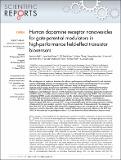Human dopamine receptor nanovesicles for gate-potential modulators in high-performance field-effect transistor biosensors
Author(s)
Park, Seon Joo; Song, Hyun Seok; Kwon, Oh Seok; Chung, Ji Hyun; Lee, Seung Hwan; An, Ji Hyun; Ahn, Sae Ryun; Lee, Ji Eun; Yoon, Hyeonseok; Park, Tai Hyun; Jang, Jyongsik; ... Show more Show less
DownloadPark-2014-Human dopamine receptor.pdf (1.034Mb)
PUBLISHER_CC
Publisher with Creative Commons License
Creative Commons Attribution
Terms of use
Metadata
Show full item recordAbstract
The development of molecular detection that allows rapid responses with high sensitivity and selectivity remains challenging. Herein, we demonstrate the strategy of novel bio-nanotechnology to successfully fabricate high-performance dopamine (DA) biosensor using DA Receptor-containing uniform-particle-shaped Nanovesicles-immobilized Carboxylated poly(3,4-ethylenedioxythiophene) (CPEDOT) NTs (DRNCNs). DA molecules are commonly associated with serious diseases, such as Parkinson's and Alzheimer's diseases. For the first time, nanovesicles containing a human DA receptor D1 (hDRD1) were successfully constructed from HEK-293 cells, stably expressing hDRD1. The nanovesicles containing hDRD1 as gate-potential modulator on the conducting polymer (CP) nanomaterial transistors provided high-performance responses to DA molecule owing to their uniform, monodispersive morphologies and outstanding discrimination ability. Specifically, the DRNCNs were integrated into a liquid-ion gated field-effect transistor (FET) system via immobilization and attachment processes, leading to high sensitivity and excellent selectivity toward DA in liquid state. Unprecedentedly, the minimum detectable level (MDL) from the field-induced DA responses was as low as 10 pM in real- time, which is 10 times more sensitive than that of previously reported CP based-DA biosensors. Moreover, the FET-type DRNCN biosensor had a rapid response time (<1 s) and showed excellent selectivity in human serum.
Date issued
2014-03Department
Institute for Medical Engineering and Science; Harvard University--MIT Division of Health Sciences and Technology; Massachusetts Institute of Technology. Department of ChemistryJournal
Scientific Reports
Publisher
Nature Publishing Group
Citation
Park, Seon Joo, Hyun Seok Song, Oh Seok Kwon, Ji Hyun Chung, Seung Hwan Lee, Ji Hyun An, Sae Ryun Ahn, et al. “Human Dopamine Receptor Nanovesicles for Gate-Potential Modulators in High-Performance Field-Effect Transistor Biosensors.” Sci. Rep. 4 (March 11, 2014).
Version: Final published version
ISSN
2045-2322